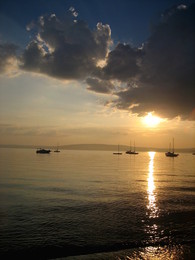Photographs

We are all haunted. Ghosts line the edges of our rooms, staring at us from the walls, emerging from old drawers and rising from the pages of our books. But we take our ghosts for granted now. Indeed, we see them every day. They are our images of moments gone by, moments that have morphed to memories, memories which are ever tossed and turned in our minds, until, like a stone in a river, what was once sharp is worn smooth and dull. Then it is impossible to be sure whether something once undeniably real and alive was ever really there, or whether it was merely a flash of imagination. Yet the ghosts linger, vivid as ever. The ghosts remind us. What is a ghost, but a photograph?
A photograph is not a moment returned from the dead. A photograph is just a sign, a shadow, a window onto a time and place that once was, but is no more. You can see the scene, the place, the person, and the moment. The memories come rushing back. Still, you can’t go back, you can only peer, hopelessly, through the window. You can touch the picture, but you cannot feel it. The ghost is ethereal. There is no cool wind rushing through your hair as once there was, no dirt squishing beneath your toes. You cannot hear the birds; you cannot smell the flowers; you cannot look around, side to side, up, down, behind. A photograph is only a ghost.
They ought to seem like something from another world. Hold the button, wait for the flash, and watch as the scene is spirited into view on Polaroid. Then seal it in an album, show it to a friend, transfer a memory from one mind to another. A scene that passed before my eyes last week is now visible to you, though you had never been there to see it. Now my ghosts haunt your mind, and even after I am gone, these ghosts may linger, to become the subjects of stories that endure. You never felt this wind, this dirt, never heard these birds or smelled these flowers yourself. So you imagine. You imagine the scene beyond the frame, and legends are born.
(You can also access the galleries via the “Photos” link on the left sidebar).
No Responses to "Photographs":
I just thought I would tell you that the comparison of a photograph to a ghost is really interesting. The way you put it makes perfect sense and I never would have thought of it that way. Also the stone in the river… I think it is a simile… is also very well written. Again, I never would have thought of it that way. I am actually jealous of the way you are able to describe things. 🙂
Josh, amazing… thats all i can say. I really love all the photos, you shot them yourself correct?? good work sir.
Andrew: Yes, I took all the pictures myself. Well, I mean, the camera took them. But I was holding it. I’m glad you like them. Also, thanks for linking to me from your blog.
Ellen: I was afraid some of my analogies might be a little tenuous. I’m glad to hear they worked for you. I would give you my secret for coming up with such metaphors and similes, if I knew what it was…perhaps its the amount of time I spend each day just sitting and letting my mind wander…
In my Philosophy and Film class, we discussed photography as being transparent. We see photographs for what we see inside them. Some people once thought that photographs cannot be art because of this transparency, this mechanical copying of what is in front of the camera. How do you feel about photographs being art?
Eric,
I do think that photographs are a form of art. In large part, this is because I disagree that photographs are simply transparent. I don’t think anyone has yet made a camera that can truly replicate the scene before it. The camera cuts many things out: surroundings, timing, and dimension, to name a few. Furthermore, no camera can really reproduce the exact color and luminosity of the scene it portends to capture.
So, the artistry of photography is largely in the way photographers deal with these limitations of the camera, deciding how to arrange a shot so that a real immersive 3D setting can fit aesthetically into a small 2D rectangle. The photographer has to decide what is worth photographing, what stays in the shot and what falls outside, what the viewing angle is, and just when in time to capture the picture. There are also more complicated issues in how to operate the camera: what detail, what resolution, what kind of film, what contrast, what color-range, should the flash fire? A photograph is in many ways a reduction of reality, and the way the photographer chooses to reduce reality into a photograph involves artistry, as does the way the photographer chooses to interpret his photograph to the rest of the world.
Photographs can also be edited and enhanced after the camera takes them, which involves another set of talents.
So, I think that photographs are a form of art. Just like any form of art, there are good photographs and bad, creative and unoriginal, interesting and bland, emotive and uninspiring. Mine are fairly run of the mill, aesthetically pleasing, but nothing here that hasn’t been done before. But a photograph can be as creative, innovative, and moving as can a painting or a symphony. There’s just a different process involved.